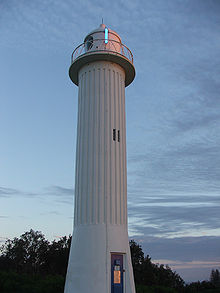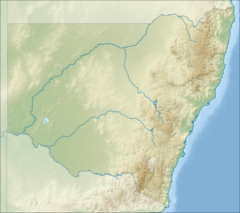Clarence River Light

Clarence River Lighthouse
|
|
|
New South Wales
|
|
| Location |
Yamba New South Wales Australia |
|---|---|
| Coordinates | 29°25′56.88″S 153°21′50.37″E / 29.4324667°S 153.3639917°ECoordinates: 29°25′56.88″S 153°21′50.37″E / 29.4324667°S 153.3639917°E |
| Year first constructed | 1866 (first) |
| Year first lit | 1955 (current) |
| Automated | 1920 |
| Deactivated | 1955 (first) |
| Construction | concrete tower |
| Tower shape | fluted cylindrical tower with balcony and lantern |
| Markings / pattern | white tower and lantern |
| Height | 56 feet (17 m) |
| Focal height | 135 feet (41 m) |
| Light source | mains power |
| Intensity | 22,000 candela |
| Range | 16 nmi (30 km; 18 mi) |
| Characteristic | Fl (3) W 15s. F Bu |
| Admiralty number | K2818 |
| NGA number | 111-5920 |
| ARLHS number | AUS-058 |
| Managing agent | Australian Maritime Safety Authority |
Clarence River Light, also known as Yamba Light or Clarence Head Light, is an active lighthouse located on Pilot Hill, a hill in Wooli Park, Yamba, New South Wales, Australia, south of the entrance of Clarence River. The current lighthouse was built in 1955, replacing a previous lighthouse built in 1880. It serves as the rear range light for two different ranges.
The first light on Pilot Hill was most probably a platform with a kerosene lamp, located on the eastern part of the hill. The first actual structure was a small wooden hut built in 1866 with a large kerosene lamp placed on a bench. It was located where the 1880 lighthouse was later built, at 29°26′1.16″S 153°21′44.26″E / 29.4336556°S 153.3622944°E. The mast from this lighthouse is on display at the Story House Museum in Yamba.
In 1878 tenders were called for a permanent lighthouse, one of five lighthouses of similar design designed by James Barnet in 1878-80, the other four being Fingal Head Light, Crowdy Head Light, Tacking Point Lighthouse and Richmond River Light. It was built by W. Kinnear at a cost of £1,097, and construction was completed in 1880.
Like the other four lighthouses, it was a rather short tower, about 7 metres (23 ft) high, with a roofed porch connecting it to a rectangular . It was visible for 6 nautical miles (11 km; 6.9 mi). A keeper's cottage was also constructed near-by.
...
Wikipedia

